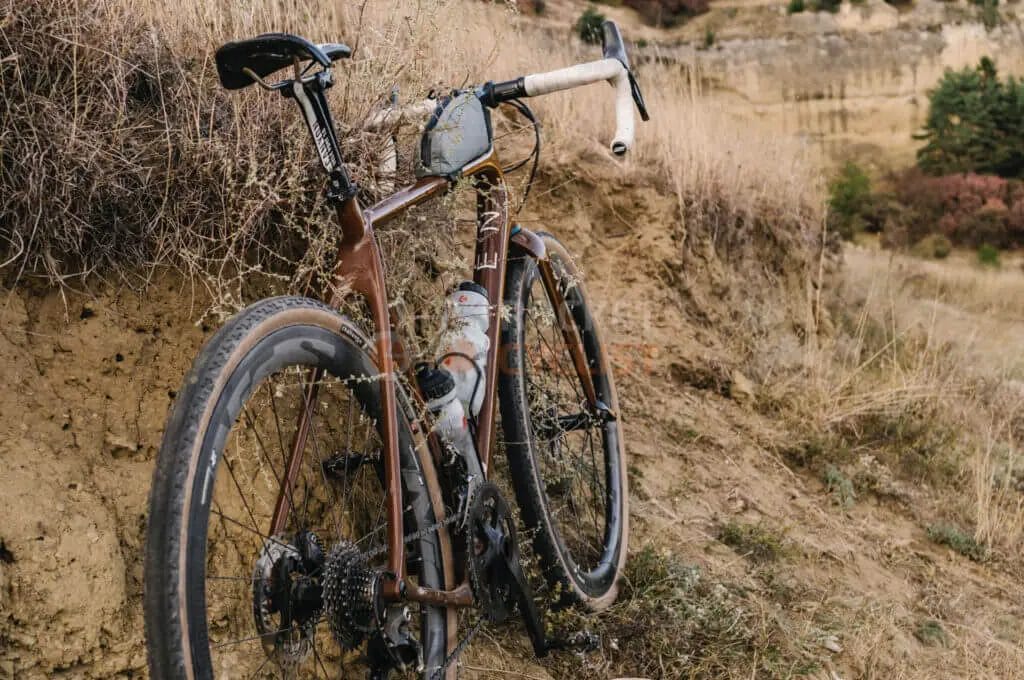Last Updated on February 27, 2024 by Vinson Lozano

Gravel biking has been gaining immense popularity among cyclists in recent years, thanks to its versatility and ability to conquer various terrains. If you’ve ever taken a closer look at a gravel bike, you may have noticed a unique feature called a dropped chainstay.
But what exactly is the purpose of this design element? In this blog article, we will delve into the world of gravel bikes and explore the reasons behind the dropped chainstay. We’ll uncover the benefits it brings to the overall performance and handling of the bike, as well as its impact on comfort and stability during off-road adventures.
Whether you’re a seasoned gravel rider or just getting acquainted with this exciting cycling discipline, understanding the concept of a dropped chainstay will undoubtedly enhance your appreciation for the engineering behind these off-road machines. So, let’s unravel the mystery and discover why gravel bikes have embraced the dropped chainstay design.
Overview of gravel bike with dropped chainstay

You’re surely familiar with road bikes and mountain bikes, and gravel bikes seem to be an interesting blend of the two. Designed to provide smooth rides on rough terrain, gravel bikes are the epitome of versatility. And one integral feature that you might notice in these bikes is the dropped chainstay. But ever wonder why this is so?
They’re designed to take the rider anywhere, from smoother asphalt to rougher gravel trails. The design elements of gravel bikes aim for durability, comfort, and a better off-road experience.
Why dropped chainstay is a common feature?
If you’ve ever noticed the area near the rear wheel of a gravel bike, you might see one side of the chainstay dropping below the other. This isn’t a design flaw, it’s the dropped chainstay, a purposeful feature common in most gravel bikes.
The dropped chainstay plays a crucial role in enhancing your gravel riding experience. It allows for larger tires and provides more clearance for mud. Moreover, by dropping the chainstay, manufacturers can make it shorter, which translates to quicker acceleration and better handling dynamics, a boon for off-road terrains. Plus, it doesn’t interfere with the drivetrain layout, letting you enjoy a flawless gravel riding experience.
So, the next time you hop on your gravel bike, remember how that dropped chainstay contributes to your adventurous ride.
Functionality of Dropped Chainstay
Venturing into the world of gravel biking, one feature that strikes you is the dropped chainstay. This unique design might seem strange at first glance, but it’s actually a result of deliberate, thoughtful design and engineering.
Increased tire clearance for off-road riding
Picture this: you’re flying down a dirt path, your adrenaline surging. The last thing you want is to worry about whether your bike can handle the rough terrains. The dropped chainstay comes in handy here.
Your chainstay’s lower position – the “dropped” part – allows for greater tire clearance. Larger tires equate to more traction, control, and shock absorption, thus making your off-road biking experience smoother and more enjoyable.
Improved responsiveness and maneuverability
But it’s not just about going down a rough, rocky path. Precision and control as you navigate those hairpin bends are just as crucial. This is where the dropped chainstay shines.
A shorter chainstay translates into snappier, more responsive handling. It enables sharper turns, especially at high speeds, increasing your bike’s maneuverability. You’ll be darting effortlessly around obstacles and taking sharp corners like a pro. Now, isn’t that a thrilling prospect?
Stability and Comfort

If you’re a biking enthusiast, chances are, you’ve come across gravel bikes with a dropped chainstay. This small, yet significant asymmetry is more than just a design quirk. It actually offers a couple of notable benefits.
Lower center of gravity for better stability
A dropped chainstay on gravel bikes puts the bottom bracket (the part that connects the two crankarms) closer to the ground. This notably lowers the bike’s center of gravity, resulting in a more stable ride. For you, this means easier control of your bike – especially helpful when you’re zipping around turns or shifting gears frequently on varied terrains.
Enhanced vertical compliance for a smoother ride
A dropped chainstay also enhances the bike’s vertical compliance, or its ability to absorb shocks vertically, providing a smoother ride. Your bike’s frame will flex more in response to bumps, resulting in less vibration transferred to you. This gives you a smoother ride and reduces fatigue, especially on longer rides.
So, next time you look at a gravel bike with a dropped chainstay, remember – it’s not just to look distinctive, but an innovative tweak to enhance stability and comfort. The dropped chainstay design encourages an enjoyable and controlled ride, especially for long, adventurous journeys on mixed terrain.
Benefits for Bikepacking and Adventure Riding

Stepping into the biking world allows you to encounter versatile breeds of cycles. As you delve deeper, you might curse the over-complications, but once you unravel their purposes, it starts making sense. Similar is the curious case of gravel bikes with a dropped chainstay. The signature character of many gravel bikes, it accommodates not just aesthetics but practical considerations as well.
Ability to accommodate larger tires and fenders
Imagine your gravel bike as a beast of burden – it needs gear, supplies, and resilience to withstand various terrains. Larger tires are the key, they grant superior traction, control, and suspension. With a traditional chainstay, there’s limited room for big tires. But with a dropped chainstay, there’s a larger clearance. This subtle rearrangement opens up space for not just broader wheels, but also can accommodate fenders. A wider tire with fenders, magic isn’t it? It makes you resilient to mud, puddles, and debris, making your ride smoother and cleaner.
Compatibility with various drivetrain configurations
The dropped chainstay is not just about tire clearance, as much as it about gear arrangement. The traditional chainstays may interfere with certain gear combinations, especially large ones. The lower positioning of a dropped chainstay offers stash space for a wider gear range,…
Frame Design Considerations

You might have noticed that gravel bikes feature a dropped chainstay. It’s not there simply for aesthetic charm; it has a crucial role in enhancing the functionality and performance of gravel bikes.
Materials and construction for optimal strength and weight balance
The dropped chainstay in gravel bikes is designed to accommodate bigger tires without unnecessarily increasing the length of the bike or interfering with the drive chain. This is crucial for maintaining the perfect balance between strength and weight. Crafting these frames requires the use of lightweight, yet durable materials, such as carbon fiber or high-grade aluminum to achieve this balance.
Impact on frame stiffness and energy transfer
The aspect of a dropped chainstay impacts the stiffness of the frame too. A stiff frame results in efficient power transfer, which is a critical factor in the performance of a gravel bike. It ensures that your efforts translate to the bike’s forward movement efficiently.
In short, the dropped chainstay on gravel bikes has both a practical and performance-related utility. From enabling bigger tires to ensuring efficient power transfer, they’re an important feature, helping you maintain ease, comfort, and functionality on those adventurous gravel rides. It is just one design element in a host of factors that make gravel bikes a favourite among bike enthusiasts.
Drawbacks and Limitations
As a gravel bike enthusiast, you’ve probably noticed the unique design feature known as the ‘dropped chainstay.’ While it has its benefits, it also brings about several drawbacks and limitations that you should be aware of.
Potential Reduced Chainring Clearance
Reduced chainring clearance is a typical limitation you’ll encounter when it comes to gravel bikes with dropped chainstays. This design makes it challenging for the bike to accommodate larger chainrings. You may have to stick to compact or mid-compact chainrings, limiting your choices for gearing options. It’s important to bear this in mind if you’re into demanding ascent courses that require larger chainrings.
Effect on Frame Stiffness and Handling Characteristics
Next is the effect on frame stiffness and the handling characteristics of your gravel bike. Usually, a straight chainstay contributes to the frame’s torsional stiffness, providing stability on rough terrains. The dropped chainstay, although giving more tire clearance, may potentially compromise this stiffness. Subsequently, it could alter the bike’s handling characteristics on a gravel path. Thus, if frame stiffness and predictable handling are paramount to you, you’ll want to thoroughly test ride a bike with a dropped chainstay before purchase.
Remember, each design has its own set of pros and cons, and the choice ultimately depends on your preferences and riding needs. While the dropped chainstay is unconventional, it might just be the feature to complement your gravel biking adventure.
Notable Gravel Bikes with Dropped Chainstay

When you’re out shopping for a new gravel bike, you might notice a common trend among modern models – a dropped chainstay.
Your eyes aren’t deceiving you; this isn’t merely an aesthetic change. There’s a functional reason behind it, and it’s all about making your biking experience the best it can be!
Introduction to popular gravel bike models featuring dropped chainstay
Keen cyclists might notice many gravel bikes on the market today have what’s known as a dropped chainstay. It’s not simply for style; the dropped chainstay design brings considerable advantages.
If you’ve spotted this design feature on popular models by Open Cycle, 3T, and Cervélo, you’re not alone. This innovative design trend is rapidly becoming a mainstay in the realm of gravel biking.
So why have brands opted for dropped chainstays? To put it simply, it allows for larger tires and shorter chainstay lengths without affecting the chain line or limiting the front chainring size. More than that, it optimally positions the drive side chainstay, allowing it to dodge the ‘bulge’ of the chainring and create more clearance for the tire. It doesn’t interfere with the Q-factor either, which is a bonus.
Indeed, the power of the dropped chainstay lies in permitting larger tires, offering improved stability for you over diverse terrains. Also, the shortened chainstay length can enhance the bike handling, making your ride more responsive and nippy. It’s a slight change that offers significant benefits, making your gravel bike more versatile, agile, and ready for any adventure!
Conclusion
You’re into biking, and perhaps, want to dig deep into the nifty features of gravel bikes. One of those features that might have piqued your interest is the dropped chainstay.
Summary of the advantages and disadvantages of dropped chainstay in gravel bikes
For starters, the dropped chainstay allows for tire-to-chain clearance without increasing the rear center dimension. In clear terms, you can mount bigger tires and still have a chain that stays tightly in position. It also helps for a smoother, less jarring ride.
Nevertheless, dropped chainstays may pose a few issues. It may lead to a more complex frame design, more costs, and potential mechanical issues like heel clearance problem.
These advantages and disadvantages may differ based on the make and model of your bike and how you ride.
Final thoughts on the importance of this design feature.
When it comes to the world of biking, even the smallest design feature can make a world of difference. Dropped chainstay isn’t an exception. Its ability to provide enhanced chain clearance and facilitate larger tires is a game-changer, overshadowing any minor cons.
So, whether you’re pounding the pavement or hitting the offroad trails, don’t overlook the role of this tiny but mighty bike feature! While it might not be on your radar now, understanding its importance may make your biking experience a whole lot better.


